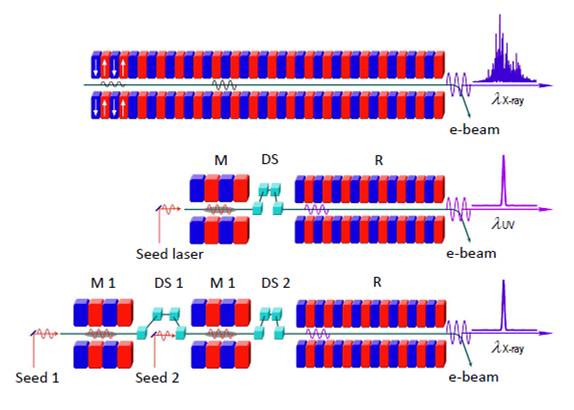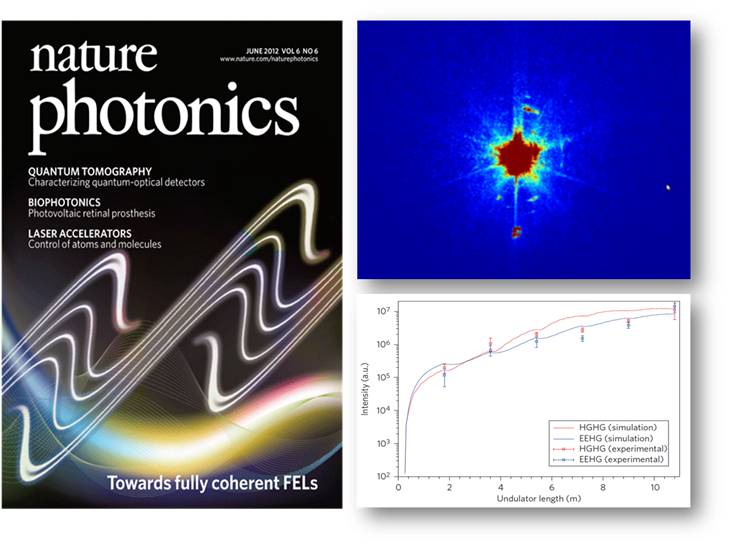






A novel principle of seeded free electron lasers demonstrated at SINAP
Scientists at Shanghai Institute of Applied Physics, Chinese Academy of Sciences have successfully demonstrated a novel principle of seeded free electron lasers, Echo-Enabled Harmonic Generation (EEHG) on Shanghai Deep UV Free Electron Laser(SDUV-FEL) facility. The result was published on <Nature Photonics>, Vol.6, No.6, 360-363, 2012.
Free-electron lasers have been successfully operated with ultra-high brightness and excellent transverse coherence at the x-ray wavelengths. One of the next goals for further improvement is full coherence. An obvious approach is to seed the free-electron laser interaction using a conventional source that has good temporal coherence. The recent work done by the SINAP FEL team shows the first lasing of a free electron laser with the echo-enabled harmonic generation scheme, which is very promising for producing coherent laser at short wavelength down to the x-ray regime. The experiment facility combines a 135.4 MeV electron accelerator and an amplifier consisting of a series of undulator magnets. The lasing is achieved at the third harmonic of the seed with a gain of about 100,000 over the spontaneous radiation. The measurements show a typical exponential growth and excellent spectral characteristics as well as good intensity stability.
It is now well-known that free-electron lasers (FELs) can provide tunable, high-intensity, ultrashort, coherent radiation for wide applications in biology, chemistry, physics, material science, etc. In the x-ray wavelength range, most of the FELs operate in the self-amplified spontaneous emission (SASE) mode. With the advent of x-ray FELs, a new era of x-ray science has arrived. While the radiation from a SASE FEL has excellent transverse coherence, it typically has rather limited temporal coherence and relatively large statistical fluctuations, because a SASE FEL starts from electron beam shot noise.
In order to meet the desire for excellent temporal coherence in many applications such as soft x-ray resonant inelastic scattering, spectroscopic studies of correlated electron materials, etc, various high-gain seeded FEL schemes, external seeding5, or self-seeding have been developed for producing stable and fully coherent laser pulse from deep UV down to the x-ray regime. Among these schemes, the latest proposed Echo-Enabled Harmonic Generation (EEHG) is a very promising candidate for fully coherent short wavelength FEL with a single stage of seeded FEL setup. A typical performance comparison of different FEL schemes, namely SASE, high-gain harmonic generation (HGHG) and EEHG, is given in Figure 1.

Figure 1 |Seeded FEL vs. SASE FEL. Upper, SASE FEL with poor temporal coherence; Middle, HGHG FEL, full temporal coherence with limited harmonic number (N~10) for a single stage; Bottom, EEHG FEL, full temporal coherence with the potentially very high harmonic number in a single stage. (M: modulator, DS: dispersive section, R: radiator)
Experimental demonstrations of EEHG mechanism have been performed at the Shanghai Deep-Ultra Violet FEL (SDUV-FEL) facility and the Next Linear Collider Test Accelerator (NLCTA) at SLAC National Accelerator Laboratory. However, no amplification has been observed in these experiments. In this letter, for the first time, the EEHG signal has been successfully amplified by the long radiator at the SDUV-FEL. The experimental results agree very well with theoretical predictions: The pre-micro-bunched electron beam with EEHG technique is amplified with a gain larger than 1000; The central wavelength of the HGHG radiation is shorter than the 3rd harmonic of the seed laser because of the negative energy chirp in the electron beam; The central wavelength of the EEHG radiation is different from HGHG due to a different wavelength dependence on the energy chirp; The bandwidths of HGHG and EEHG spectrum are different due to a different bandwidth dependence on the nonlinear energy chirp.
Link for the paper published on<Nature Photonics>:
http://www.nature.com/nphoton/journal/v6/n6/full/nphoton.2012.105.html
Link for the interview on<Nature Photonics>:
http://www.nature.com/nphoton/journal/v6/n6/full/nphoton.2012.118.html

Fig.2, Left, cover of the latest issue of <Nature Photonics>, which shows the phase spaces of modulated electron beams. Up-right, FEL radiation from EEHG FEL, bottom-right, gain curves of EEHG and HGHG FEL.

Fig. 3, The SDUV-FEL facility is comprised of a linear electron accelerator with beam energy up to 200 MeV and a multi-purpose FEL amplifier. The FEL amplifier with EEHG setup, including a pair of modulator and a 9 meter long radiator (see Methods), designed to study the novel principles of seeded FELs, is capable to do kinds of FEL experiments and make thorough comparison studies.